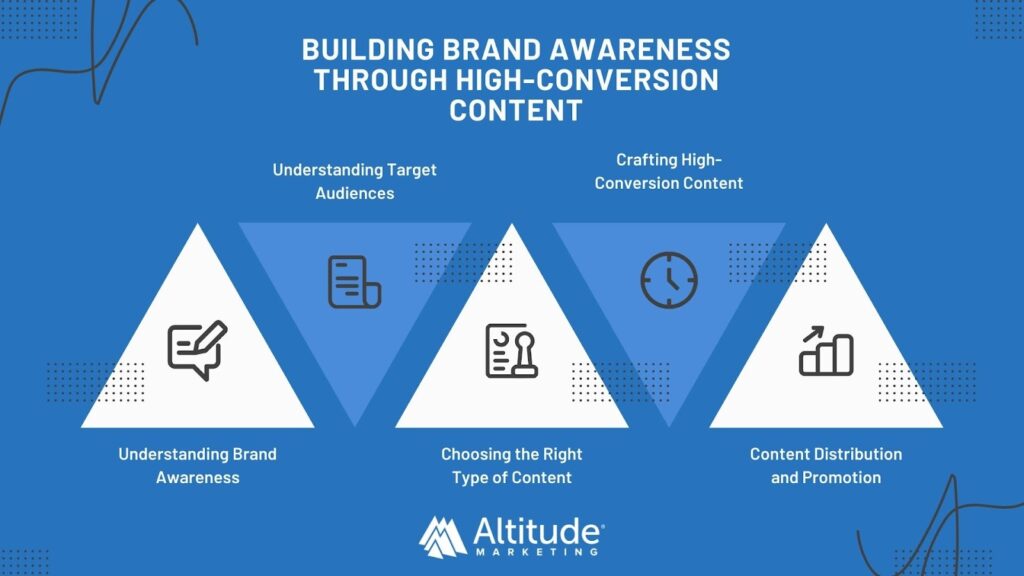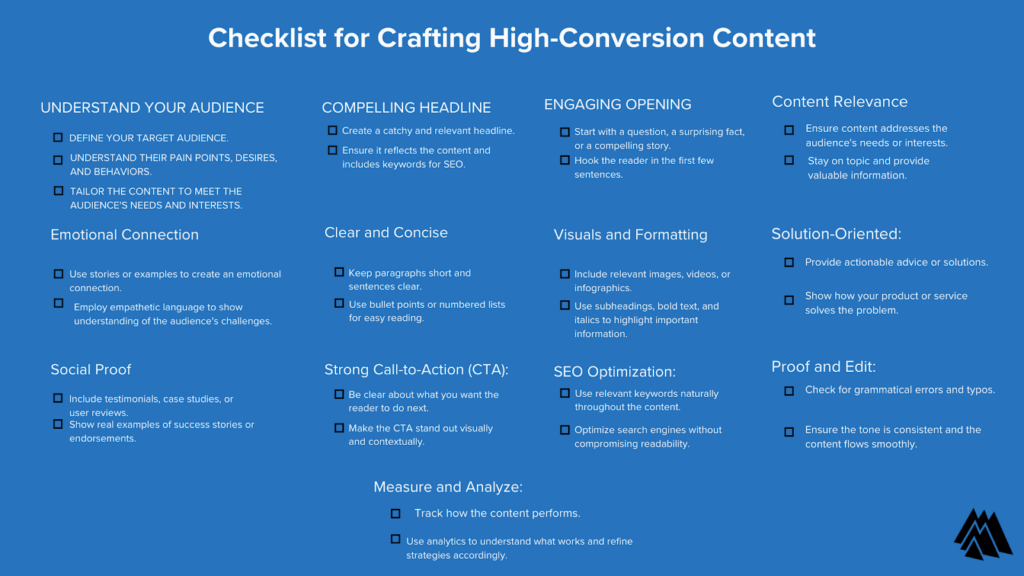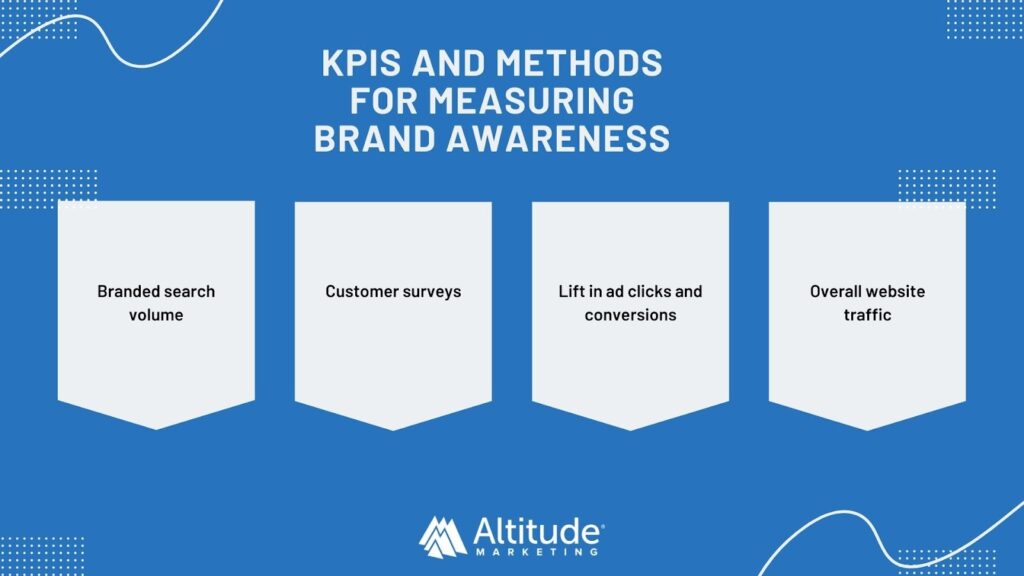Brand awareness refers to how familiar customers are with your company and offerings. It’s crucial for laying the foundations of loyalty and repeat business. When people know your brand, they’re much more likely to consider you when making a purchase. A strong brand evokes positive emotions and associations, making it easier for buyers to trust you and feel confident choosing your company.
Content marketing plays a huge role in building awareness by selling your underlying business values instead of just products, services and solutions. This allows you to share your unique story and qualities, forging deeper connections with target audiences.
In this article, we’ll explore how high-conversion content can effectively contribute to developing powerful brand awareness. From crafting compelling stories to choosing the right platforms, impactful content strategies transform how audiences perceive and relate to your brand.
Let’s break down the core elements of content that catch attention, drive conversions, and cement your brand name in minds for the long run. I’ll make sure we focus on actionable tips you can implement straight away to get your brand seen and remembered.
Overview
9 Steps in Building Brand Awareness Through High-Conversion Content

Step 1: What Is Brand Awareness?
Have you ever wondered why certain brands instantly spring to mind when you think of a product category while others remain unknown? The degree of top-of-mind presence comes down to the depth of prospect brand awareness. Companies with high awareness consistently grab customer attention.
But what defines brand awareness exactly? It refers to the level of buyers’ familiarity with a brand and its offerings. This crucial marketing concept influences perceptions, drives purchase decisions, and cements loyalty.
In essence, robust brand awareness fosters trust in a company, evokes positive emotional associations, and builds invaluable brand equity. It empowers brands to ascend beyond niche status into household names.
There are two pillars to brand awareness:
Brand Recognition
Brand recognition is teh ability of customers to identify a brand by its logo, name, packaging, or other visual identity cues. This facilitates unaided awareness. Buyers can retrieve the brand from memory when prompted with a related product category. This shows the brand is firmly cemented in their mind; if they need a vendor, this is one that will come to mind.
Brand Recall & Association
Brand recall is the strength of buyers to recall and associate positive attributes or experiences with a brand. This goes beyond simple recognition and delves into the emotional or memorable connections buyers have with the brand. Effective brand recall and association contribute to enhanced brand loyalty and prospect preference.
The numbers speak volumes about the power of branding – 75% of buyers are more likely to purchase from brands familiar with their preferences and history. And 59% prefer buying from brands they already know, driving revenue.
Step 2: Understanding Target Audiences
Identifying your true target audience proves indispensable for content that resonates and converts. Analyzing demographics, behaviors, interests, and values spotlights who you should speak to and what messaging they crave. Audience segmentation and fictional buyer personas help in breaking down mass targets into intimate portraits of priority groups based on shared qualities. This hyper-customization enhances relevance.
For example, segmenting by speciality, seniority, location or employer type provides a targeted foundation. Building detailed personas for a clinical researcher vs laboratory director brings further clarity to the tailoring approach.
Above all, intimately knowing your customers must inform content creation at every step – from ideation to channel selection and metrics analysis. Content made for and by the people you serve attracts, engages, and converts better by orders of magnitude.
Step 3: Choosing the Right Content
When aiming to boost brand awareness, the format of content significantly impacts results. While blog posts efficiently convey stories, videos emotionally showcase products at scale. Infographics artfully transform complex data into visual dividends and case studies reveal authentic proof. The key lies in aligning types to audience preferences, campaign goals, and steps in the buyer’s journey.
For example, an awareness-focused video series could tell the founding story and brand vision. A consideration-phase infographic may highlight clinical trial successes for credibility. An email sequence of customer success stories targets decision-making cycles.
Testing a combination while tracking performance indicators ushers in optimization. The learnings amplify future branding efforts through ultra-targeted delivery.
Step 4: Crafting High-Conversion Content
At the core of successful B2B branding is the creation of resonating content that establishes genuine connections with target audiences. Strategically crafted stories, pain point relevance, and solution-driven advising convert readers into customers.
Compelling hooks instantly capture attention while relatable narratives spur emotional investment. Discussing shared frustrations builds trust in the brand as an ally. Case studies establish thought leadership clout. And clear calls-to-action incentivize desired behaviors.
Long-term consistency also matters – regularly publishing fresh branding materials across channels reminds audiences of why they fell in love with you in the first place!
Use the below checklist for crafting high-conversion content:

Step 5: Content Distribution & Promotion
Content distribution is a critical aspect of content marketing. 82% of marketers are actively investing in content marketing. Distributing and promoting content through various channels and formats is vital for reaching new audiences and boosting brand awareness. Social media, email marketing, and search engine optimization (SEO) are extremely effective distribution channels.
Social media enables brands to publish, share, and promote content to a wide audience. Platforms like LinkedIn allow content to spread rapidly. Email marketing delivers content directly to subscriber inboxes, allowing more targeted distribution. SEO helps make content easily discoverable through search engines. Paid advertising also amplifies content reach and drives engagement.
Maximizing organic reach and engagement starts with high-quality, relevant content that truly resonates with the target audience. Following SEO best practices and encouraging social sharing also helps content spread. Building an engaged community creates evangelists who actively promote content. Influencer partnerships leverage existing audiences and credibility to extend content reach.
Measuring and tracking performance is crucial for understanding content effectiveness. Key performance indicators assess awareness and engagement, while analytics tools provide data-driven insights.
Step 6: KPIs & Methods for Measuring Brand Awareness
Measuring brand awareness demonstrates the impact of marketing efforts. It requires defined key performance indicators to quantify awareness and track content effectiveness. Useful KPIs and measurement methods include:

Step 7: Deploy Analytics Tools
Google Analytics investigates website traffic, user behavior, and content performance, allowing you to measure the impact of your work passively. The brand tracking software monitors ongoing awareness and analyzes campaign results. Social media analytics examines engagement to understand content effectiveness.
Interpreting all this data transforms metrics into actionable insights. Analyzing campaign performance identifies opportunities to optimize content and distribution for greater awareness. Results reveal how to refine strategies to better resonate with audiences.
Step 8: Building Brand Trust and Authority
Building brand trust and authority establishes credibility within an industry. 81% of buyers need to trust a brand to consider a purchase. Consistent, high-quality content positioned around unique insights is crucial. This content generates leads, boosts conversions, and cements expert status.
Maintaining ethical and transparent content practices involves consistent authenticity across channels. A clear voice, tone, and style reinforced by honesty and transparency builds trust. Sharing genuine opinions and experiences establishes thought leadership authority.
User-generated content and customer testimonials demonstrate real-life experiences that resonate. Influencer partnerships extend reach and associate brands with credible voices. All this provides social proof that a brand keeps customers’ best interests in mind.
A strategic, audience-focused approach fuses creativity with customer understanding. Consistency, authenticity, and transparent practices make brands reliable sources of valuable information. This authority converts audiences into loyal brand advocates over time through content that educates and empowers.
Step 9: Exploring Unconventional Content Marketing Strategies
Exploring unconventional content marketing strategies using emerging technologies can help brands differentiate themselves. Innovative approaches like virtual reality and integrating new platforms create immersive, engaging experiences that drive conversions.
Several key technologies shape the future of content marketing:
The AI market is to reach a staggering $407 billion by 2027. Artificial intelligence (AI) powers data analysis, personalized content, and optimized distribution through machine learning algorithms. The Internet of Things (IoT) collects behavioral data through connected devices, providing valuable customer insights. Machine learning models predict preferences and interests for highly relevant content.
Staying updated on the latest advancements is crucial for brands. This knowledge empowers intelligent, data-driven decisions that amplify content performance. Understanding these innovations also enables adaptation to an evolving landscape.
The future competitive edge relies on unconventional strategies that captivate audiences. Integrating cutting-edge technologies builds awareness, trust, and authority. Personalized experiences resonate strongly, driving higher conversion rates over time.
As we have seen the key steps to build brand awareness through high-conversion content. However, people make mistakes, so let’s explore the common mistakes in content marketing for brand awareness to avoid them in the future.
Common Mistakes in Content Marketing for Brand Awareness
Many brands struggle with content marketing execution. Common mistakes include inconsistent quality, lack of strategy, measurement issues, and ineffective distribution. Avoiding these pitfalls is essential for improving awareness.
Producing high-quality content at scale is challenging. Unique angles tailored to search engine results can better engage target audiences. A consistent voice that aligns with brand identity also enhances content.
An unclear, inconsistent strategy leads to ineffective content. Defining target audiences, topics, distribution methods, and metrics via research establishes alignment. This consistency resonates across channels.
Measuring return on investment is difficult without key performance indicators. Leveraging analytics tools like Google Analytics tracks awareness progress. These insights optimize future efforts for better results.
Choosing the right distribution channels to reach audiences can be tough. Social media, email, SEO and advertising each enable targeted content delivery to drive awareness. Other issues like saturation and competition also cause problems. Updating strategies based on research and embracing innovations in emerging technologies help brands cut through the noise to connect with customers. Avoiding these missteps ultimately improves content quality and conversion rates.
Conclusion
Brand awareness reflects how well a brand resonates in the marketplace. High awareness means consumers recognize and understand a brand’s offerings, making it easier to attract business. Compelling marketing, robust products, and customer engagement all influence perception.
Studying success stories reveals effective brand building strategies. These insights describe how leaders boost awareness and conversions through content quality and consistency. Because awareness is key for growth, dedicating resources to boost visibility and trust drives loyalty and sales over time.



